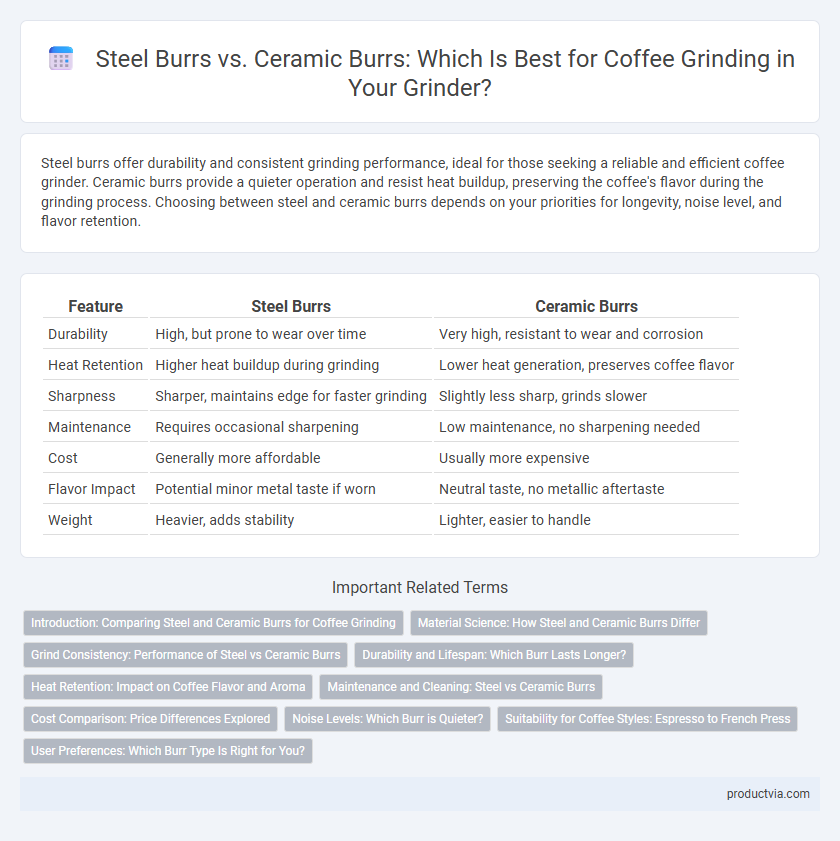Steel burrs offer durability and consistent grinding performance, ideal for those seeking a reliable and efficient coffee grinder. Ceramic burrs provide a quieter operation and resist heat buildup, preserving the coffee's flavor during the grinding process. Choosing between steel and ceramic burrs depends on your priorities for longevity, noise level, and flavor retention.
Table of Comparison
| Feature | Steel Burrs | Ceramic Burrs |
|---|---|---|
| Durability | High, but prone to wear over time | Very high, resistant to wear and corrosion |
| Heat Retention | Higher heat buildup during grinding | Lower heat generation, preserves coffee flavor |
| Sharpness | Sharper, maintains edge for faster grinding | Slightly less sharp, grinds slower |
| Maintenance | Requires occasional sharpening | Low maintenance, no sharpening needed |
| Cost | Generally more affordable | Usually more expensive |
| Flavor Impact | Potential minor metal taste if worn | Neutral taste, no metallic aftertaste |
| Weight | Heavier, adds stability | Lighter, easier to handle |
Introduction: Comparing Steel and Ceramic Burrs for Coffee Grinding
Steel burrs offer durability and faster grinding speeds, making them ideal for high-volume coffee preparation, while ceramic burrs provide superior heat resistance and maintain sharpness longer, resulting in consistent grind size and flavor preservation. The choice depends on factors such as grinding frequency, desired grind precision, and maintenance preferences. Understanding the performance differences between steel and ceramic burrs ensures optimal coffee extraction and taste quality.
Material Science: How Steel and Ceramic Burrs Differ
Steel burrs are typically made from high-carbon stainless steel, offering superior toughness and resistance to chipping under high grinding pressures, making them ideal for consistent, heavy-duty coffee grinding. Ceramic burrs, composed of zirconia or alumina ceramics, provide greater hardness and wear resistance, which preserves sharpness longer but are more brittle and prone to cracking if exposed to moisture or impact. The thermal conductivity of steel burrs allows faster heat dissipation during grinding, reducing heat buildup that can affect coffee flavor, whereas ceramic burrs retain heat, potentially altering the grind consistency over time.
Grind Consistency: Performance of Steel vs Ceramic Burrs
Steel burrs offer superior grind consistency due to their precise manufacturing tolerances and durability, maintaining sharp edges longer under frequent use. Ceramic burrs provide a consistent grind initially but may wear faster, leading to variable particle sizes over time especially with hard coffee beans. Consistent particle size distribution from steel burrs enhances extraction uniformity and flavor profile in brewed coffee.
Durability and Lifespan: Which Burr Lasts Longer?
Steel burrs offer superior durability and resist chipping or cracking, making them ideal for heavy, frequent coffee grinding. Ceramic burrs maintain sharpness longer and are harder than steel, but they are brittle and prone to breakage if mishandled. Overall, steel burrs tend to have a longer lifespan in demanding grinder use due to their toughness and resistance to wear.
Heat Retention: Impact on Coffee Flavor and Aroma
Steel burrs retain heat more quickly during grinding, which can elevate the bean temperature and potentially alter the delicate flavor and aroma compounds in coffee. Ceramic burrs dissipate heat more efficiently, preserving the coffee's nuanced taste by minimizing thermal impact. Choosing ceramic burrs helps maintain the optimal sensory profile of freshly ground coffee.
Maintenance and Cleaning: Steel vs Ceramic Burrs
Steel burrs require regular cleaning to prevent rust and maintain sharpness, as their metal composition is prone to corrosion if exposed to moisture. Ceramic burrs offer superior resistance to wear and do not rust, making them easier to maintain with less frequent cleaning needed. Both types benefit from routine brush cleaning, but steel burrs demand more careful drying and occasional lubrication to ensure longevity.
Cost Comparison: Price Differences Explored
Steel burrs generally cost less upfront than ceramic burrs, making them a budget-friendly option for many coffee enthusiasts. Ceramic burrs, while pricier initially, tend to last longer and maintain sharpness better, potentially reducing the need for replacements and long-term expenses. Evaluating the total cost of ownership highlights that ceramic burrs may offer better value despite their higher initial price point.
Noise Levels: Which Burr is Quieter?
Steel burrs generate more noise during coffee grinding due to their harder material and sharper edges, which cause louder grinding sounds. Ceramic burrs operate more quietly, absorbing vibrations and producing less noise, making them ideal for noise-sensitive environments. Choosing ceramic burrs can significantly reduce sound levels without compromising grind consistency.
Suitability for Coffee Styles: Espresso to French Press
Steel burrs offer consistent, sharp grinding ideal for espresso, delivering precise particle size for optimal extraction. Ceramic burrs provide a slower, cooler grind, preserving coffee flavors suited for French press and cold brew methods. Both materials support a range of coffee styles, but steel burrs excel in fine grinding while ceramic burrs are preferable for coarser grinds.
User Preferences: Which Burr Type Is Right for You?
Steel burrs offer durability and consistent grinding performance, making them ideal for users who prioritize longevity and precision in coarse to fine grounds. Ceramic burrs excel in heat resistance and produce less noise, preferred by those seeking a cooler grind and quieter operation for delicate coffee flavors. User preferences often depend on grind consistency, maintenance ease, and personal taste sensitivity when choosing between steel and ceramic burrs.
Steel burrs vs Ceramic burrs for coffee grinding Infographic

 productvia.com
productvia.com